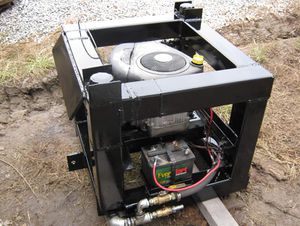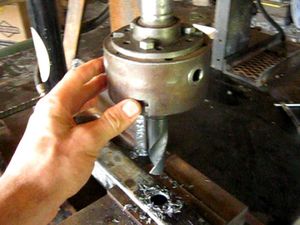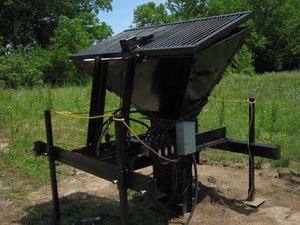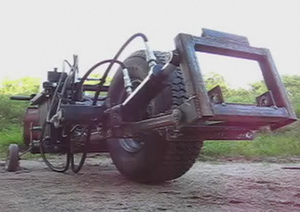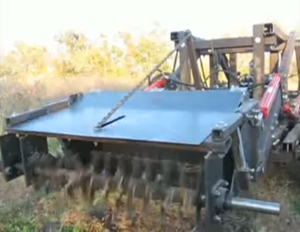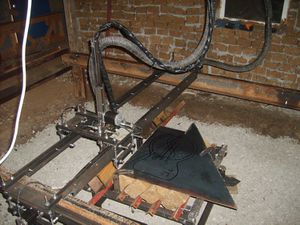Crash course on OSE: Difference between revisions
| Line 31: | Line 31: | ||
* '''[[:Category:Transport|Transportation]]''' - includes a Tilting Microcar powered by a lightweight version of the Power Cube. | * '''[[:Category:Transport|Transportation]]''' - includes a Tilting Microcar powered by a lightweight version of the Power Cube. | ||
* '''[[:Category:Digital_Fabrication|Digital Fabrication]]''' - RepLab up to Hot Metal Processing. | * '''[[:Category:Digital_Fabrication|Digital Fabrication]]''' - RepLab up to Hot Metal Processing. | ||
* '''[[:Category:Materials|Materials]]''' - [[Aluminum_Extraction_From_Clays|Aluminum Extraction from Clay]] | * '''[[:Category:Materials|Materials]]''' - [[Aluminum_Extraction_From_Clays|Aluminum Extraction from Clay]]; [[Bioplastic Extruder]] including bioplastic synthesis from plants | ||
===Current Status=== | ===Current Status=== | ||
Revision as of 09:51, 17 February 2011
In other languages: Português ° Français
Crash Course
This is a Crash Course on Open Source Ecology. In the next 15 minutes, you will be brought up to date on all the work of OSE from the last 4 years. Email crashcoursemoderator at gmail dot com for support.
Overview for New People
To see what we do, see the GVCS in 2 Minutes video. Open Source Ecology was founded in 2004 by Marcin Jakubowski. We are a network of farmers, engineers, and supporters that for the last two years has been creating the Global Village Construction Set, an open source, low-cost, high performance technological platform that allows for the easy, DIY fabrication of the 50 different Industrial Machines that it takes to build a sustainable civilization with modern comforts. The GVCS lowers the barriers to entry into farming, building, and manufacturing and can be seen as a life-size lego-like set of modular tools that can create entire economies, whether in rural Missouri, where the project was founded, in urban redevelopment, or in the heart of Africa.
We have an ambitious program for product release of the 49 remaining technologies within 2 years and a $2.4M budget - which we abbreviate as our 50/2/2 program. The period for this is 2011-2012.
Key Features of the GVCS
These are the Key Features of the GVCS, and if you want to see the full set of values, see Core Values of OSE.
- Open Source - we freely publish our 3d designs, schematics, instructional videos, budgets, and product manuals on our open source wiki, and we harness open collaboration with technical contributors.
- Low-Cost - The cost of making or buying our machines is on average, 8 times cheaper than buying from an Industrial Manufacturer, including labor costs of $15/hour for a GVCS fabricator.
- Modular - Motors, parts, assemblies, and power units can interchange, where units can grouped together to diversify the functionality that is achievable from a small set of units.
- User-Serviceable - Design-for-disassembly allows the user to take apart, maintain, and fix tools readily without the need to rely on expensive repairmen.
- DIY - The user gains control of designing, producing, and modifying the GVCS tool set.
- Closed Loop Manufacturing - Metal is an essential component of advanced civilization, and our platform allows for recycling metal into virgin feedstock for producing further GVCS technologies - thereby allowing for cradle-to-cradle manufacturing cycles.
- High Performance - Performance standards must match or exceed those of industrial counterparts for the GVCS to be viable.
- Flexible Fabrication - It has been demonstrated that the flexible use of generalized machinery in appropriate-scale production is a viable alternative to centralized production.
- Distributive Economics - We encourage the replication of enterprises that derive from the GVCS platform as a route to truly free enterprise - along the ideals of Jeffersonian democracy.
- Industrial Efficiency - In order to provide a viable choice for a resilient lifestyle, the GVCS platform matches or exceeds productivity standards of industrial counterparts.
Scope of the GVCS
- Mechanical Infrastructure - life-size, Lego-like construction set for agricultural and utility equipment in which modularity is emphasized. The mechanical infrastructure is based on a chassis (tractor, microtractor, car, bulldozer) with modular add-ons. Implements, motors, and power units can interchange, thereby maximizing the range of uses that can be composed from a small set of components. For example, the power unit can be interchanged readily between the tractor, bulldozer, or car.
- Agriculture - The food infrastructure for a resilient community (Open Source Agroecology) aims to demonstrate a best-practice system for feeding 100-200 people with a core team of 4 agricultural generalists, or Open Source Agroecologists.
- Energy Infrastructure - includes Fuel, Motive Power, and Electricity. The energy infrastructure consists of solar energy capture either by the Solar Turbine or by plants. The Solar Turbine uses solar heat directly when the sun is shining, or stored as plants trap solar energy via photosynthesis, where the energy is harvested in the form of plant biomass.
- Housing - The housing infrastructure consists of a number of mulipurpose tools: CEB Press, Sawmill, Cement mixer, Modular Housing Units, Living Machines and others.
- Transportation - includes a Tilting Microcar powered by a lightweight version of the Power Cube.
- Digital Fabrication - RepLab up to Hot Metal Processing.
- Materials - Aluminum Extraction from Clay; Bioplastic Extruder including bioplastic synthesis from plants
Current Status
last updated: 15. February 2011.
The following prototypes and products are developed until now:
| The Power Cube II is an universal, self-contained power unit that consists of an engine coupled to a hydraulic pump for providing power to different devices in the form of hydraulic fluid at high pressure. The Power Cube is a module that can be attached to the LifeTrac, Microtrac, Bulldozer, and Open Source Car (OSCar) platforms. It connects to other devices via quick couplers and quick-connect hydraulic hoses.
Links: short and long (50min) video. | |
| The Drill Press is for drilling 1″ and larger holes directly in metal without pre-drilling. It contains a hydraulic motor for the drilling and a hydraulic cylinder for the down pressure – so this is a literal press, and it is not short on torque or power as the motor can sustain up to 20 hp. We are using our Universal Rotor for the motor.
Links: documentation, video. | |
| The Compressed Earth Brick (CEB) Press allows for rapid (16 brick per minute), low-cost, high-quality construction from on-site earth. The CEB Press is used to compress clayey soil (20-30% clay by volume) from local or on-site soils into structural masonry (700-1000 PSI) building blocks. Stabilization with cement may be used for additional weather resistance. CEB also lends itself to the construction of floors, paved areas, retaining walls, storage structures, or any other structures where a uniform, structural building block is desired.
Links: The Liberator, The CEB Story, initial field testing, pressing bricks, disassembly, crating (packaging), wiki documentation, machine overview, the frame, the controller. | |
| LifeTrac is a versatile, 4-wheel drive, full-sized, hydraulically-driven, skid-steering tractor of 18-200 hp with optional steel tracks. LifeTrac is intended to be a minimalist but high-performance, lifetime design, design-for-disassembly workhorse and power unit of any land stewardship operation. It features easy serviceability by the user. Its modular nature allows for quick attachment of implements; interchangeability/stackability of multiple power units (Power Cubes) for adapting power level to the task at hand; quick attachment of all hydraulic components via quick-coupling hoses; including quick interchangeability of hydraulic motors for use in other applications.
Links: Build (wiki with videos), Stage I of Development, Prototype II Completed, moving. | |
| MicroTrac is a scaled-down, a walk-behind version of the the full-sized LifeTrac to address the need for a microtractor. We are using most of the same components as LifeTrac, except we are shrinking the structural members – to retain part interchangeability between MicroTrac and LifeTrac.
Links: completed, zero turn, wiki documentation, Microtrac Prototype II, Prototype II Challenge. | |
| The Soil Pulverizer can be attached to LifeTrac and pulverizes the soil to a fine consistency which can be used in preparation for pressing Compressed Earth Bricks (CEBs).
Links: blog, construction and test (short video), test (video). | |
| CNC Torch Table is a cutting table. A computer can control the torch head making clean sharp cuts on XYZ axes. Prototype I has been built, but has not been operated successfully because the radiation emitted by the plasma cutter that was used with the table caused electronics failure. We will finish Prototype I by retrofitting it with open source stepper motor controllers.
Links: wiki, Build (wiki), Plasma cutter in action, Open Source Torch Table Part 4, Part 5, Part 6. |
Future Plans
Proposal 2012 contains all the updated information about the vision of the GVCS. The goal is to gather $2.4M of support to complete the GVCS in 2 years (the end of 2012).
GCVS components expected in 2011 (some if funded) are:
- Power Cube III – 55 HP (Horse Power)
- CNC Torch Table I
- LifeTrac III
- Soil Pulverizer III
- Modern Steam Engine I – Our goal is on the order of $500 in materials cost for a 1 kW generator, with favorable cost scaling for higher power. Introduction and more videos are available here: 1 kW Steam Engine Electric Generator Prototype
- Ironworker machine II
- Aluminum extraction from clay
If funded other parallel developments are possible.
Distributed power generation is a clear goal – the next major field of endeavor for Factor e Farm, which would allow us to fuel our operation for free – from agriculture, off-grid fabrication workshop, to living and transportation.
After the GVCS completion the first OSE Community will be built and Education and Training in 2-year immersion program are planned.
TED Fellows has accepted Marcin Jakubowski, the founder of OSE! This year he will present a Fellow’s talk and this may give the opportunity for a real TED Talk!
Open Source Ecology won the MAKE Green Project Contest which will cover all expenses for their trip to the 2011 Maker Faire where LifeTrac will be shown.
OSE is participating in the Buckminster Fuller Challenge 2011, an annual international design Challenge awarding $100,000 to support the development and implementation of a strategy that has significant potential to solve humanity’s most pressing problems.
Adam Shilling, a True Fan, is planning a multiplayer online game based on the GVCS as the inspiration for its connection to the real world. Adam is going to South America to meet real people – to assess the needs of real communities. The project will link gaming to the real world – where money exchanged ends up purchasing things like tractors or renewable energy equipment for villages in South America.
A Documentary Film about Factory E Farm may come in the future.
Check out our new website - http://opensourceecology.org (forthcoming by Feb. 14, 2011). Support OSE to help us make this happen.
For Technical Developers
If you would like to help bring this project to completion, we invite proactive collaboration on many fronts. First, see Proposal 2012 for a list of the 50 technologies that we are developing, for their product ecologies, and for general information about the development process. Second, read and re-read the Core Values of OSE, as these inform all of the technical, organizational, and community development around the project. Then, read about the technical development process at the GVCS Development Template, and the publishing standards for our results at the Product Template. The key page is the GVCS Tools Status - a GVCS master index for displaying the status and needs of each project, and see a simpler table at GVCS tools. If there is no entry for a given project and step, that indicates that no work has yet been done. Each entry in the table is hyperlinked so you can find out the status of each step, and the next steps and needs become transparent. At this stage, after general assessment of a given project, you are ready to contribute. Begin by filling out the Team Culturing survey according to the notes and instructions stated on that page. Then, contact the Project Manager for that project to see how exactly you can become involved, or, find out about Project Manager Duties if you would like become a project manager yourself. You can also see the GVCS Budget for a general description of the expected development and prototyping costs.
Success on the above requires that project managers are recruited for each of the 50 projects. It also depends on developing a corresponding organizational, web, and funding strategy.
For Organizational Developers
Organizational infrastructure includes organizational form, organizational architecture, process design, operations management, product management, resource development, donor relations, human resources, handling of finances, transparency, conflict resolution, media development, public relations, and other tasks that allow the technical development to flow smoothly. We are presently installing all of this infrastructure. At present, we are working on becoming an NGO or nonprofit, and we are defining the organizational architecture. On the resource development front, our first step is to install an instance of CiviCRM to handle contacts. To get involved, first fill out the Team Culturing survey. Then email our Operations Manager or Resource Developer to get involved. You can read about 50/2/2, our GVCS Organizational Infrastructure that is being developed to make this happen, the GVCS Resource Development Strategy to support the Organizational Infrastructure, GVCS Web Strategy to facilitate development, GVCS Media Development Strategy to communicate the work, GVCS Forum Policy to handle entry-level discussion and to filter it into actual development progress, learn how to help OSE win Awards and Contests. What else is missing here?
For Web Developers
The web infrastructure includes the main website, wiki, blog, forums, design repository, CiviCRM platform, and community portal. We are presently reworking all of this infrastructure.
For Organizational Developers
Organizational development involves all the supporting roles that lead to the 50/2/2 Apollo Program for the GVCS, and the positioning of the project as a world-class effort of improving the human condition. Organizational development involves the management, architecture, organiztional form, fundraising, marketing, PR, and other functions that this project needs to reach its goals.
Transparency should include disclosure of strategy, infrastructure, team, and other details that make development work possible.
Keywords
Required Reading for Developers
- OSE Specifications
- Proposal 2012
- GVCS Development Template
- Product Template
- Development Team
- Wiki Policy
- Forum Policy
Other
Conferences, Media Development,
FAQs
To Do Items
See GVCS Tasks
